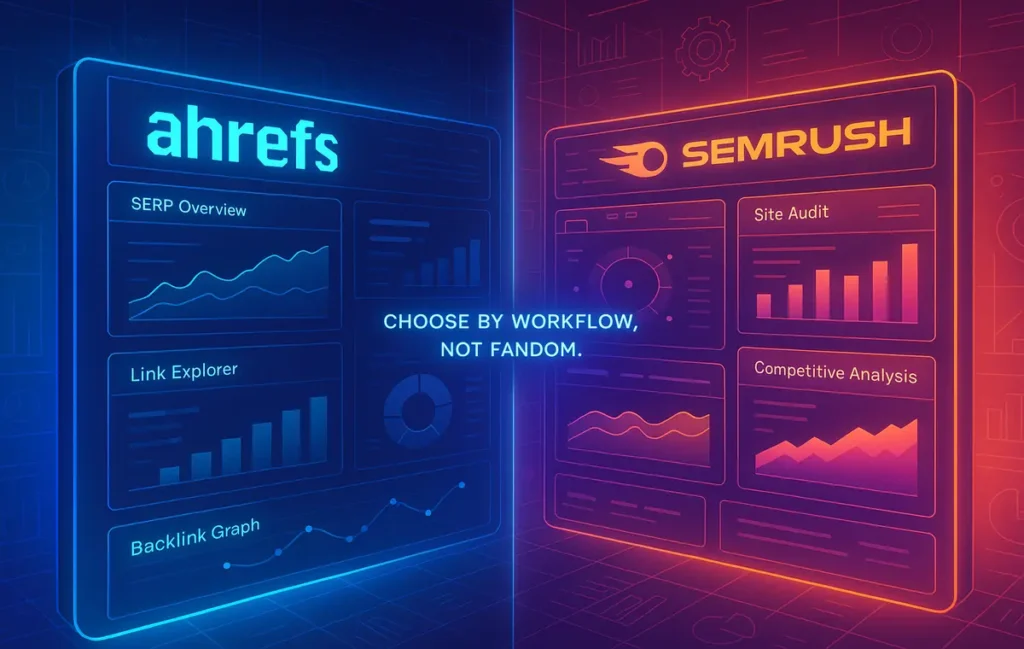🚀 Intro: The 2025 Decision Most Marketers Keep Postponing
If you run search seriously in 2025, you can’t dodge this choice: Ahrefs or Semrush. Both are mature, both are loved (and loudly defended) by their fans, and both have grown well beyond “just keyword tools.” But a smarter way to frame the question is this: Which one produces more ROI for your specific workflow? For a content-led solo operator, the best answer often isn’t the same as for a performance-driven agency running multi-channel campaigns.
This guide is a comparison pillar—not a fanboy take. We’ll map the tools to the jobs: keyword discovery and validation, backlink forensics, technical SEO, competitor insights, reporting, and the economics of credits. Then we’ll run playbooks for three personas (Blogger/Creator, SMB Growth Team, Agency) and show how to decide in under 10 minutes using a simple scoring framework. For deeper context, you can always dive into our dedicated Ahrefs Review and Semrush Review—this article sits above those to help you pick a lane without cannibalizing your research time.
💡 Nerd Tip: Before you compare features, define your weekly SEO rituals (e.g., “3 briefs, 1 audit, 1 link outreach report”). Buy the tool that accelerates those rituals, not a toolbox you’ll only use on paper.
🧭 Quick Snapshot: Where Each Tool Leans
In a sentence, Ahrefs is a precision instrument for link intelligence and keyword validation, while Semrush is an all-in-one marketing cockpit that includes SEO plus PPC, social scheduling, and reporting. Neither description is the whole truth, but it captures the center of gravity. If you want the long version with receipts, keep reading.
To keep this practical, we’ll also thread natural, SEO-friendly internal links so you can branch out: historical context in Top SEO Tools and How They’ve Evolved, strategy patterns in SEO Content Writing, and budget considerations in Affordable SEO Tools for Keyword Tracking.
🧪 How We Compare (Methodology That Reflects Real Work)
Comparison articles go wrong when they benchmark what people don’t actually do. We used a workflow-first lens:
-
Discovery & Validation: How fast can you go from a seed idea to a publishable keyword brief you trust?
-
Technical Confidence: Can you diagnose site health and ship prioritized fixes without drowning in noise?
-
Authority Strategy: How well can you see your link graph, spot gaps, and run outreach that isn’t guesswork?
-
Competitive Context: Do the numbers help you understand rivals’ momentum and content economics?
-
Reporting & Ops: Does the tool reduce spreadsheet glue? Can it serve a team’s cadence?
-
Economics: Credits, seats, export limits—do they scale with your actual usage?
To avoid fluff, each section below ties to measurable outcomes—time-to-brief, time-to-fix, and insight-per-click—not just “we liked the UI.”
🔍 Keyword Research & Content Workflows
Ahrefs shines when you want trustworthy difficulty signals and a sense of “how search actually behaves” for a topic cluster. Its keyword database, parent-topic grouping, and SERP overview simplify intent mapping. If your week is built around generating briefs that writers can execute, Ahrefs’ mix of KD + clicks data + SERP analysis produces fewer false positives. Pair it with the outline you draft in SEO Content Writing and you’ll publish with confidence that the query can earn.
Semrush counterpunches with topic clustering, content templates, and SEO Writing Assistant that go beyond discovery into production. If your process includes on-the-fly optimization inside Docs or WordPress, Semrush’s content tools reduce the back-and-forth between research and writing. It also helps when you manage multiple markets, because the interface nudges you to explore related variations and questions you might miss in a purely numerical workflow.
Bottom line: If the job is to validate and brief fast with strong difficulty cues, Ahrefs feels surgical. If the job is to shepherd content from idea to on-page optimization inside one suite, Semrush shortens the path.
💡 Nerd Tip: For a new site, combine Ahrefs’ parent topic view with a low-competition “seed cluster” of 30–50 terms. Then, use Semrush’s Writing Assistant on the top five pieces only—the ones most likely to rank within 90 days.
🔗 Backlink Intelligence & Authority Strategy
Backlinks are where Ahrefs built its legend. The link index and the way it surfaces lost/new/referring domains and anchor text patterns make it easy to tell a story: who’s linking, why, and where to focus next. For broken link building, resource page outreach, or competitor gap hunts, Ahrefs’ explorer and link intersect remain efficient. The graphs aren’t just pretty—they lead to actions.
Semrush has grown its index steadily and adds integration benefits: because it sits next to your keyword, PPC, and social data, you can prioritize link efforts around pages with high PPC spend or upcoming campaigns. For agencies, that context reduces “nice to have” hunts in favor of outreach tied to revenue.
If your world revolves around digital PR and you live inside link reports, you’ll likely prefer Ahrefs’ granularity. If you want link insights nested inside a broader campaign calendar, Semrush becomes more persuasive.
💡 Nerd Tip: In outreach planning, filter to referring domains with topic alignment and recent activity. A stale but powerful domain isn’t always worth more than a moderately authoritative site that still publishes weekly.
🛠️ Technical SEO & Site Audits
A great audit is equal parts coverage and prioritization. Semrush often wins the hearts of technical generalists here because its Site Audit translates findings into prioritized to-dos, ties issues to crawlability and Core Web Vitals, and plugs into task systems and reporting without extra glue. For teams juggling multiple properties, that reduces context switching.
Ahrefs has built a solid crawler with clear reporting and useful internal link opportunities surfaces. If you prefer a cleaner, faster path to “what breaks rankings on this site today?” Ahrefs’ interface can feel lighter—especially for solo operators who export, fix, and re-crawl on their own cadence.
For deep technical work (JS rendering quirks, custom headless stacks), both tools will still share space with a dedicated crawler in your stack. But for 80% of weekly issues—redirect loops, image bloat, orphaned pages, thin content—either will do the job. The difference is how the audit fits into your team’s rhythm and whether you need multi-channel reporting alongside it.
💡 Nerd Tip: Align your audit sprint with publishing cycles. Fix internal links and thin pages inside the same two-week window you drop new content—Google responds faster when the whole site signals improvement.
⚡ Ready to Pick Your SEO Workhorse?
Run our 10-minute scoring grid with two task-based trials. Let data—not fandom—decide whether Ahrefs or Semrush delivers ROI for your workflow.
🧭 Competitor Analysis & Market Intelligence
This is where Semrush’s “marketing cockpit” approach flexes. Market Explorer, traffic estimates, share-of-voice charts, and PPC + PLA + social peeks let you triangulate competitor strategy beyond SEO. If you run paid search or manage a brand where PR, PPC, and SEO co-evolve, having these lenses side by side is pure leverage.
Ahrefs focuses its competitive energy on SERP-centric clarity: which pages win, what links matter, and where topic gaps exist. For content-only feuds where your plan is “publish better stuff and earn better links,” Ahrefs keeps you honest without extra noise.
Both can mislead if you take traffic estimates too literally; use the curves to detect momentum rather than to report absolute numbers. The winner here depends on whether your marketing scope is SEO-only or multi-channel.
💡 Nerd Tip: Build a Competitor Momentum Board: monthly, snapshot top pages added, new links by domain quality, and PPC creative changes. Direction beats precision for decision-making.
🧩 Integrations, Reporting & Team Ops
Semrush is opinionated about workflows. It wants to be your ops layer for SEO + PPC + social and offers reporting templates, client portals, and writing integrations that reduce tool-hopping. Agencies love this because account managers can live in one place and ship dashboards that non-SEOs actually read.
Ahrefs is happier as the sharp instrument you bring to research, audits, and link strategy. Many teams pair it with their own reporting stacks or BI tools. That’s not a weakness; it’s a design decision. If your organization already has a reporting backbone, Ahrefs slots in cleanly.
For in-house teams with limited analyst time, Semrush’s prebuilt reports often compress hours into minutes. For craft-obsessed SEOs who prefer exporting and shaping data by hand, Ahrefs respects your need for speed and focus.
💡 Nerd Tip: Whatever you choose, set “time-to-insight” SLAs. If a weekly report takes longer than 20 minutes to assemble, change the template or the tool.
💸 Pricing, Credits & the Economics of Usage
Sticker prices fluctuate, and both vendors tweak credits. What matters most is your usage pattern:
-
Ahrefs often makes you think in terms of crawl budget and export discipline. If your work is research-heavy with lots of SERP and linking queries, learn to batch: define questions in advance, run exports once, work offline while you ideate, then return with sharper follow-ups.
-
Semrush encourages breadth. The all-in-one feel nudges teams to keep PPC, social, and SEO inside one bill, which can be cheaper than three separate vendors. But breadth can tempt you into superficial dashboards—protect your focus.
If you’re truly torn, run two-week, task-based trials: assign the same outcomes (3 briefs, 1 audit, 1 outreach plan) and track time spent and confidence level. The winner is the one that saves more hours at the same quality bar.
💡 Nerd Tip: Don’t overpay for seats you don’t need. A shared research seat + separate read-only reporting seats (or exported dashboards) is often enough for SMBs.
🧑🏫 Real-World Use Cases (Three Personas, Three Picks)
1) Blogger/Creator focused on organic growth.
Your week is 70% research/writing, 20% light technical, 10% outreach. You live and die by finding green-field long-tails that compound. Ahrefs usually wins because the SERP snapshots, parent topics, and link cues muffle false positives. When you need production help, complement with writing tools from your CMS or lean tactics from SEO Content Writing.
2) SMB Growth Team juggling SEO + Ads + Social.
You report to leadership across channels. Your stack must answer “where should we invest this month?” in one view. Semrush typically pays back faster: combine keyword, PPC, and competitive views, then ship dashboards without a BI detour. Use Affordable SEO Tools for Keyword Tracking for supplemental rank tracking if budgets are tight.
3) Agency handling disparate clients.
You need repeatable playbooks, client-friendly dashboards, and at-a-glance health. Semrush helps account managers stay synchronized with media buyers and social leads. Add Ahrefs as a second seat for your senior SEO when link forensics and fine-grained research matter. This “A + S” combo costs more, but it defuses internal debates and wins pitches.
💡 Nerd Tip: Agencies—price your retainers around time-to-first-insight. Tools aren’t a pass-through; they’re speed multipliers your clients pay to access.
🧩 Mini Comparison
Keyword Research:
Ahrefs = lean, SERP-true difficulty + parent topics → faster validation.
Semrush = broader topic scoping + writing integrations → smoother production.
Backlinks:
Ahrefs = detailed link graph & intersect → surgical outreach.
Semrush = link data with campaign context → easier stakeholder buy-in.
Technical Audits:
Ahrefs = crisp, fast exports for solo fixes.
Semrush = prioritized fixes + cross-channel reporting for teams.
Competitive Intel:
Ahrefs = content rivalry clarity.
Semrush = market-level context (SEO + PPC + social).
Reporting & Ops:
Ahrefs = plays nice with your BI.
Semrush = done-for-you dashboards and templates.
🧰 Playbooks You Can Run This Week
Playbook A: Topic Cluster from Zero
Seed 3–5 core themes. In Ahrefs, expand to parent topics, pull SERP snapshots, and mark intent (informational, transactional, mixed). Draft 5 briefs. Then bring the top two into Semrush’s Writing Assistant for on-page polish and structured FAQs. Publish within seven days.
Playbook B: Audit → Fix → Report
Run a full crawl. If you’re solo, Ahrefs’ cleaner audit may help you ship faster. If you’re a team, Semrush’s priority list helps assign tasks. In both, focus on internal link opportunities and thin page consolidation first—these are fast, compounding wins. Report changes weekly in a single chart: indexed pages, CWV pass rate, and sessions.
Playbook C: Link Strategy with Guardrails
Export competing domains and intersect referring domains in Ahrefs to surface high-impact prospects. Filter by topical fit and recency. Build pitches aligned to content that earns, not “please link.” If leadership wants context, drop a Semrush report that connects these targets to competitor ad pushes—now your outreach protects paid spend too.
💡 Nerd Tip: In each playbook, cap yourself at three metrics that matter. More dashboards ≠ more growth.
🧮 ROI Framework: Choose by Outcome, Not Opinion
Here’s a simple scoring grid you can complete in 10 minutes. Score each 1–5 for importance (I) and 1–5 for tool fit (F). Multiply to get a weighted score.
-
Time-to-Brief (Discovery → Outline): Ahrefs F=?, Semrush F=?
-
Time-to-Fix (Audit → Live Changes): Ahrefs F=?, Semrush F=?
-
Authority Strategy (Link Gaps → Outreach List): Ahrefs F=?, Semrush F=?
-
Cross-Channel Reporting (SEO + PPC + Social): Ahrefs F=?, Semrush F=?
-
Seat & Credit Economics (Next 6 Months): Ahrefs F=?, Semrush F=?
Tally your totals. If there’s a tie, pick the tool with the shorter learning curve for your team—adoption beats theoretical power every time.
💡 Nerd Tip: Re-score after 90 days. Your needs evolve; your tool can, too.
🧱 Challenges & Fixes (So You Don’t Bounce in Month Two)
When teams churn off either platform, it’s rarely because the tool is “bad.” It’s because workflows weren’t reshaped to exploit strengths. If your writers aren’t using the content checks, production won’t speed up. If your SEOs don’t convert audits into tasked sprints, health won’t improve. If outreach runs without authority maps, links won’t move the needle.
Fix it by ritualizing usage. Add a Monday research block and a Thursday audit block to your calendar, then hold yourself to publishing one Cluster A and fixing one Cluster B every week. Stack review sessions around outcomes (rank movement, fix counts, links earned), not tool screenshots. And keep your tool stack lean. One great platform plus a few hand-picked utilities beats six half-used logins.
💡 Nerd Tip: Build a 30-minute Friday “intent check”—is every draft still aligned to the SERP? Update briefs before you ship the wrong piece.
📬 Want More No-BS Marketing Stacks?
Join our weekly memo for playbooks on SEO, attribution, and content ops—curated by NerdChips. We send what we use, not what trends.
🔐 100% privacy. No noise. Just practical frameworks that move your metrics.
🧠 Nerd Verdict
There’s no universal champion—there’s only the tool that compounds your specific workflow. If your moat is content precision and link strategy, Ahrefs keeps you honest and fast. If your mandate is multi-channel growth with stakeholder-ready reporting, Semrush earns its seat. Many teams end up hybrid: Ahrefs for surgical intel, Semrush for ops and reporting. That’s not fence-sitting; it’s how winners ship.
And yes, the choice touches brand, too. At NerdChips, we bias toward decisions that reduce time-to-insight and increase publishing velocity. Pick the platform that does both for you this quarter.
❓ FAQ: Nerds Ask, We Answer
💬 Would You Bite?
If you had to ship three SEO briefs and one technical sprint next week, which tool saves you more hours at the same quality bar—Ahrefs or Semrush?
Crafted by NerdChips for creators and teams who want their best ideas to travel the world.



